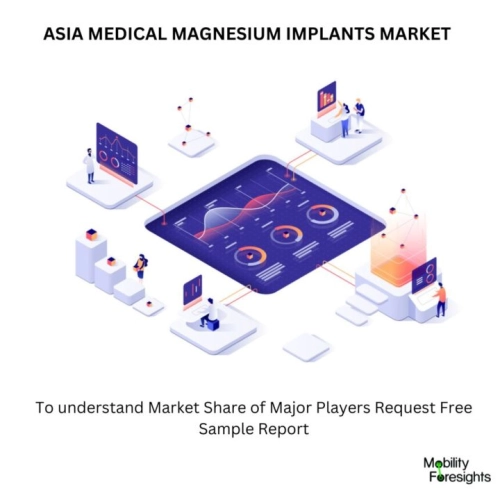
- Get in Touch with Us

Last Updated: Apr 25, 2025 | Study Period:
ASIA MEDICAL MAGNESIUM IMPLANTS MARKET
KEY FINDINGS:
The Asia Medical Magnesium Implants Market is on a steady growth trajectory, fueled by the increasing adoption of bioresorbable implants in the regionâs healthcare industry. Countries such as China, Japan, and South Korea are leading the charge in adopting innovative medical technologies, including magnesium implants that offer advantages over traditional metallic devices. As Asia grapples with a rising elderly population and an increase in bone-related diseases, magnesium implants are emerging as a solution that aligns with the demand for minimally invasive and cost-effective treatments.
Magnesium implants are particularly gaining traction in orthopedic surgeries, such as bone fracture repair and joint stabilization, due to their biocompatibility and natural degradation within the body. The market is also seeing increased applications in cardiovascular procedures, such as magnesium stents, which reduce the need for follow-up surgeries to remove the implant. As medical technology continues to evolve in Asia, magnesium implants offer a promising alternative to traditional materials, especially in complex surgeries where long-term metallic presence could pose complications.
However, the Asia Medical Magnesium Implants Market faces several challenges. Regulatory processes in different countries, including China and India, are complex and time-consuming, often delaying the introduction of new magnesium-based products to the market. Despite these hurdles, continuous research and development efforts, along with government support for innovative medical technologies, suggest a bright future for the market. Asia's growing focus on improving healthcare infrastructure, particularly in developing nations, is expected to further boost demand for magnesium implants.
The Asia Medical Magnesium Implants Market refers to the growing sector of bioresorbable medical implants made from magnesium alloys that are used in a variety of surgical procedures. These implants are particularly favored for their ability to degrade naturally in the body, eliminating the need for secondary surgeries to remove them. As the medical industry in Asia moves toward innovative and cost-effective healthcare solutions, magnesium implants are increasingly adopted for orthopedic and cardiovascular applications.
There are different types of magnesium implants available in the market, such as screws, plates, pins, and stents. These are used primarily in orthopedic surgeries for bone fixation, fracture repair, and joint stabilization. Additionally, magnesium-based stents are being developed for cardiovascular applications, where their ability to gradually resorb in the body can help reduce complications associated with permanent implants.
The benefits of magnesium implants include their biocompatibility, which reduces the risk of adverse immune reactions, and their ability to naturally degrade, making them ideal for temporary fixation in the body. However, challenges remain, such as controlling the degradation rate of magnesium and ensuring that implants maintain strength throughout the healing process. Regulatory hurdles and the need for extensive clinical trials also pose challenges to widespread adoption in the Asian market.

| Company Name | Product Description | Analyst View |
| Syntellix AG | Magnesium-based orthopedic screws and plates for fracture repair | Expected to lead in Asiaâs orthopedic market due to clinical efficacy and high demand for bone fixation. |
| Biotronik | Magnesium cardiovascular stents for artery blockages | Anticipated to gain market share as demand for bioresorbable stents grows in Asiaâs cardiovascular sector. |
| Weigao Group | Magnesium alloy plates for spinal surgeries | Poised for growth as it meets the increasing demand for bioresorbable spinal implants in China. |
| U&I Corporation | Magnesium orthopedic implants designed for pediatric use | Positioned to address growing pediatric surgical needs in Asia, focusing on fracture repair in children. |
| Zimmer Biomet | Magnesium pins and screws for joint stabilization and trauma surgeries | Expected to benefit from the growing trend toward minimally invasive procedures in Asia. |
| Sr No | Toc |
| 1 | Market Segmentation |
| 2 | Scope of the Report |
| 3 | Research Methodology |
| 4 | Executive Summary |
| 5 | Introduction |
| 6 | Average B2B Price |
| 7 | Regional Analysis and Trends |
| 8 | Impact of Technological Advancements on the Asia Medical Magnesium Implants Market |
| 9 | Demand Technology Trends in the Industry |
| 10 | Major Key Drivers in the Market |
| 11 | Recent Product Developments |
| 12 | Manufacturing Footprint for Major Players |
| 13 | Recent Orders in the Asia Medical Magnesium Implants Market |
| 14 | Market Dynamics and Strategic Initiatives |
| 15 | Analysis of Asia Medical Magnesium Implants Market Initiatives on Market Growth |
| 16 | Impact of Sustainable Practices on Market Trends |
| 17 | Market Size, Dynamics, and Forecast by Product Type, 2024-2030 |
| 18 | Market Size, Dynamics, and Forecast by Application, 2024-2030 |
| 19 | Market Size, Dynamics, and Forecast by End-User, 2024-2030 |
| 20 | Market Size, Dynamics, and Forecast by Region, 2024-2030 |
| 21 | Pricing Strategies and Market Positioning |
| 22 | Competitive Landscape |
| 23 | M&A in the Past 12 Months |
| 24 | Growth Strategy of Leading Players |
| 25 | Market Share of Vendors, 2024 |
| 26 | Company Profiles |
| 27 | Unmet Needs and Opportunity for New Suppliers |
| 28 | Conclusion |